Beyond the Forward Tees

The Golf Course as an Impartial Equalizer for All Genders, Ages, & Abilities
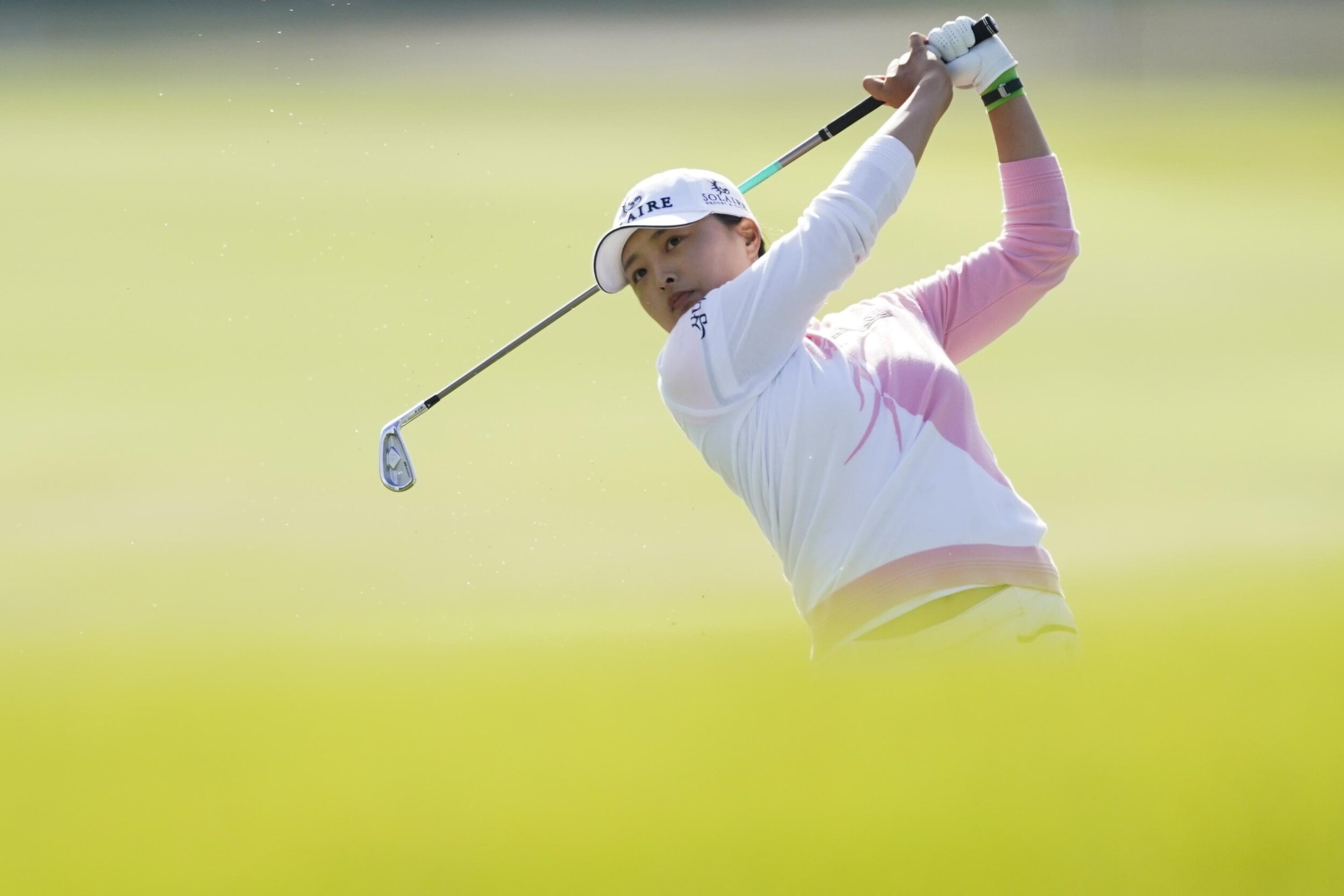
The LPGA tour is comprised of the most elite golfers on the planet and LPGA tournaments are some of the most exhilarating sporting events to watch. They strike the ball with precision, power, and finesse. Their membership is robustly diverse with 125 international members representing 32 countries, plus the organization hosts prestigious global tournaments in Asia & Europe. For 71 years, the LPGA has been investing in young women and female golf professionals by creating scholarship funds to support youth and accessibility golf initiatives. The LPGA has a profound mission to make golf more diverse and inclusive for all.
Despite all of this promising work to grow the game, professional women’s golf does not receive an inkling of the attention, funding, or sponsorship opportunities as men’s professional golf. With a lack of live cable broadcasts, LPGA tournaments are typically reduced to app streams, or if they are broadcast on cable it is on tape delay well after the winner has been announced. What will it take for women’s golf to become the main event?
Beth Ann Nichols, one of the few female golf writers, postulated in a March 16, 2021 article for Golf Week Magazine that course set up for LPGA tournaments is the predominant factor hindering professional women’s golf viewership. Nichols advocates for the LPGA to play shorter courses, with a recommended tournament course length closer to 6,000 yards (the equivalent of playing slightly closer than the blue tees) to lead to more scoring opportunities and in turn, more viewers for LPGA tournaments. Nichols proposes that the act of moving up select tee boxes would drive viewership for the LPGA, and lack of driveable par 4’s is a drawback for viewers. Bryson DeChambeau does not hit the green on a par 4 because the PGA shortened the courses, he does so because there is a specific science to his practice & has been working hard/bulking up for years. Bryson has the most successful ratio of attempts at driving greens on par 4 because he gains far more shots than he loses. He has the best Return to Player (RTP) and it is proof the risk pays off for him when he employs this strategy.
Nichols argument for shortening the courses is that "there is no more cost-effective way for the LPGA to immediately increase the entertainment value of its tour than to set up more courses that are conducive to low scoring." The Lotte Championship in Kapolei, HI, which was played about a month after Nichols article was released, moved three tee boxes forward, including #7, a par 5, that was moved up 65 yards. That’s a significant amount. This is a course where players typically card scores of -20 and below. In my opinion, if the LPGA’s strategy for increased viewership is moving tees forward to increase scoring opportunities, this should be reserved for courses where scores are generally higher and players frequently struggle.
One of my issues with this article is that viewers need not be enticed to watch womens golf; there is already a strong demand across a diverse mix of demographics to watch live cable broadcasts of LPGA tournaments. Despite this, at the end of February 2021, there were three (3) men's tournaments broadcast live on network cable: PGA Tour WGC Workday, Champions Tour Cologuard, & Puerto Rico Open. Meanwhile, the LPGA Gainbridge at Lake Nona Country Club was reduced to tape delay & app streams, a slap in the face to fans who wanted to watch and a detrimental blow to young female golfers everywhere. Take a look at the strides being made in the WNBA and NWSL, imagine what equal programming for LPGA would do for the growth of the game amongst young girls. There is also demand from beginner and senior citizen demographics to watch golf that is more realistic. For example, a majority of amateur golfers find watching LPGA tournaments to be more relatable because, while they still cannot hit it as far or as perfectly as the ladies, it is a more verisimilitudinous and achievable depiction of a round than the PGA tour, whose players bomb it 350+ off the tee leaving a measley wedge shot and a putt. Alison Whitaker, former player on the Ladies European tour, hypothesized on the Filthy Lipout podcast, “It’s a different game. The women are still playing the courses as they were designed to be played, which I actually really like, whereas the guys are overpowering them. I’m kind of caught in between because I’d love to have a real appreciation for how good those players are in the women’s game, but I don’t know that I’m ready to sacrifice course design for it.”
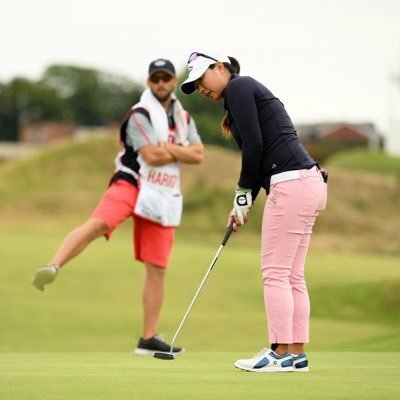
Travis Kreiter, professional LPGA tour caddy for his fiance, Mina Harigae, shared his perspective on the matter with me and it helped me consider the other side of the argument, “All of these players who you listed, along with my fiancé whom I caddy for would play shorter tees if given the opportunity. The goal is to make as many birdies as possible and shoot the lowest score possible.” Professional LPGA golfers are on board with the proposal because this is their career, this is a competition, there is money on the line and any chance to win and make more money will be taken. This led me to the conclusion that when a career and annual earnings are on the line, perhaps taking advantage of an easier course set up would be wise. On the flip side, as Travis puts it, “Women who don’t play professionally should challenge themselves to make as many birdies and pars as possible from whatever tees are comfortable. The goal is not to struggle, it’s to have fun and play your best.”
There is also the perspective of shorter hitters on the LPGA tour. I spoke with Ben Harpring of WomensGolf.com about how the goal of moving tees closer should not be for entertainment, but rather to give shorter hitters and folks we don’t typically see in the top 10 or top 20 more opportunities to go low. “The scores across tournaments over the years show that they can play incredible golf anywhere. But the big thing is that it’s misleading, in my opinion; the winning scores can be very low, even the top-5 finishers, but then there is typically a massive drop off. Creating a couple more scoring opportunities for the 85% or more of the field that cannot reach most of the par 5’s in two is the basic ask I believe. Just move a couple of par 5’s up to make them reachable for everyone, and not just 5-10 players.”
While I disagree with the motivation for Nichols’ stance, there is some validity to increasing scoring opportunities from a player/caddy perspective. But, changing the course layout isn’t the only solution, we should be focusing efforts on narrowing the pay gap between female and male golfers, increasing live broadcast accessibility of professional women's golf, as well as encouraging larger name sponsors to invest in women's golf tournaments & female golfers, as is happening at the upcoming ISPS Handa World Invitational event. Suggesting players move up a tee is a distraction from real issues plaguing both professional and recreational women's golf.
Why is the LPGA curiously taking Nichols’ reform to heart? Who would stand to gain what if this practice continues? Do we not have faith in golf fans to watch female professional golf tournaments without scores in the low 60’s and below every tournament? Will they put an asterisk next to uber low scores (a la Roger Maris’ homerun record) for those achieved at courses where multiple tee boxes were moved a significant distance forward? Professional female golf has many obstacles, but the course is the one aspect of golf that does not discriminate.
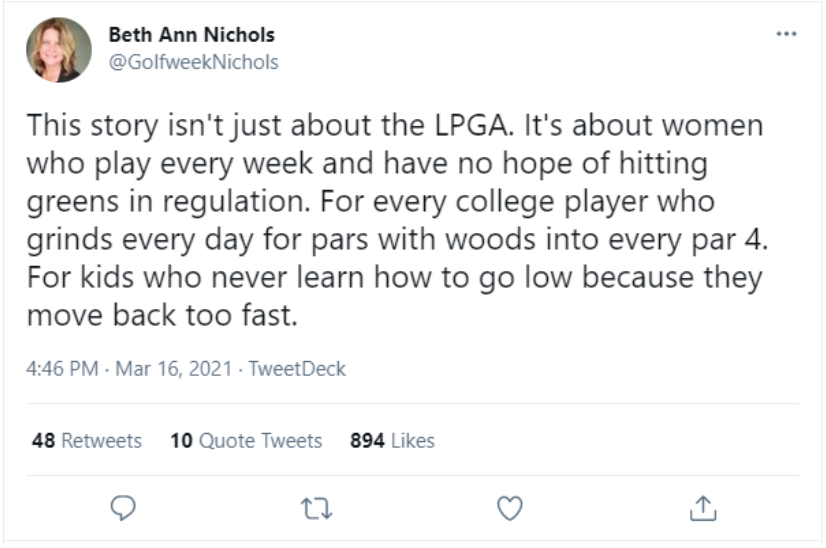
In tweets following the article, Nichols asserted that even average female players should not feel shame from hitting from the forward tees despite being above average players . I disagree even more firmly.
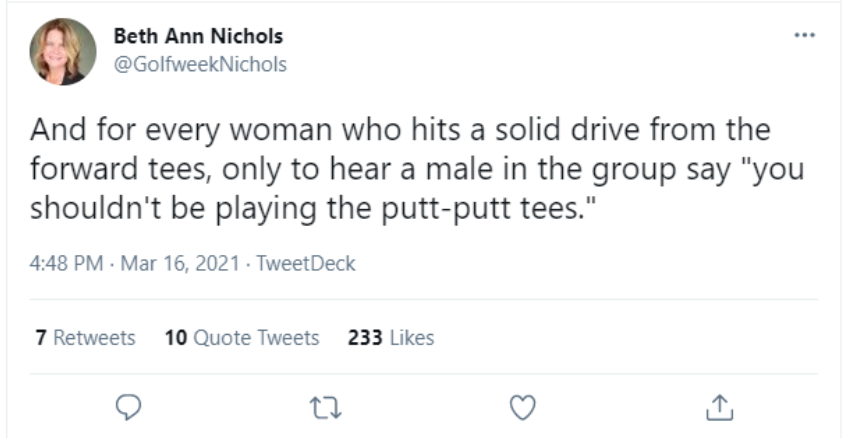
I say that is a ludicrous perspective.
Tee positions are genderless, rather they are based on skill level. Women should not feel limited to the forward tees, nor should men be afraid to tee it forward. Plenty of men play course lengths that are too long for their skill levels and plenty of women play course lengths that are too short for their skill levels - why is this? Could it be that mainstream golf media is perpetuating these stereotypes?
When I first started learning golf over a year and a half ago, I said from day one that I would not remain at the forward tees forever and I couldn't understand why so many women don't challenge themselves/are not encouraged to move back tees as they progress. Most courses don't even have par calculations for females for tees further back than gold or white, however there are plenty of ladies playing consistently well from the tips. The course design is the great equalizer of golf, however Nichols' article tries to villainize it.
Jamie O’Neill, a professional women’s long drive competitor, said her course does not even provide par calculations for women playing anything further back than the two forwardmost tees. “Generally, I play from the tips. The length and handicap makes it appropriate for me. Playing in ladies league/red tees is slow, since I have to wait on every par 4 for the green to clear. I’ve had to request tees to be added to the handicap systems since they only have reds.” How can female golfers feel welcome on the golf course when they can’t easily post their scores from the tee’s they are playing while men can typically post from all tee boxes? Beginner male players are encouraged and even expected to successively move back tees as they progress, so where is this same fervor for female players? Women should be given the same opportunities as men on the golf course to play the game that best suits their ability.
Henry Stetina, Director of Instruction at Red Hawk Golf Club in Las Cruces, NM, as well as program coordinator for the New Mexico State University Professional Golf Management Program, says all players should start out learning from a shorter course and work their way backwards. “I like the Operation 36 model of teaching players (regardless of skill, age, or gender) to score par from 25 yards out and then progress to longer courses while achieving par from each distance.” As for elite professionals, they most definitely can handle current course lengths (6,200+ yards) - are you going to be the one to tell Lexi Thompson, Anne Van Damm, Patty Tavatanakit or Sophia Popov to move up a tee? I think not. I don’t want to live in a world where women are limited to the forward tees and not given the opportunity to show their strength. I challenge you to play golf that is enjoyable but also maintains the appropriate level of challenge. Challenging your game will give you a deeper sense of connection and relevancy to the women competing on the LPGA. But this notion will not be widely accepted, if PGA Club Professionals do not do their part to make golf courses more welcoming to everyone by using more inclusive language when referring to tee boxes. It’s time for signage that classifies tees to be based on skill level/distance not on gender.
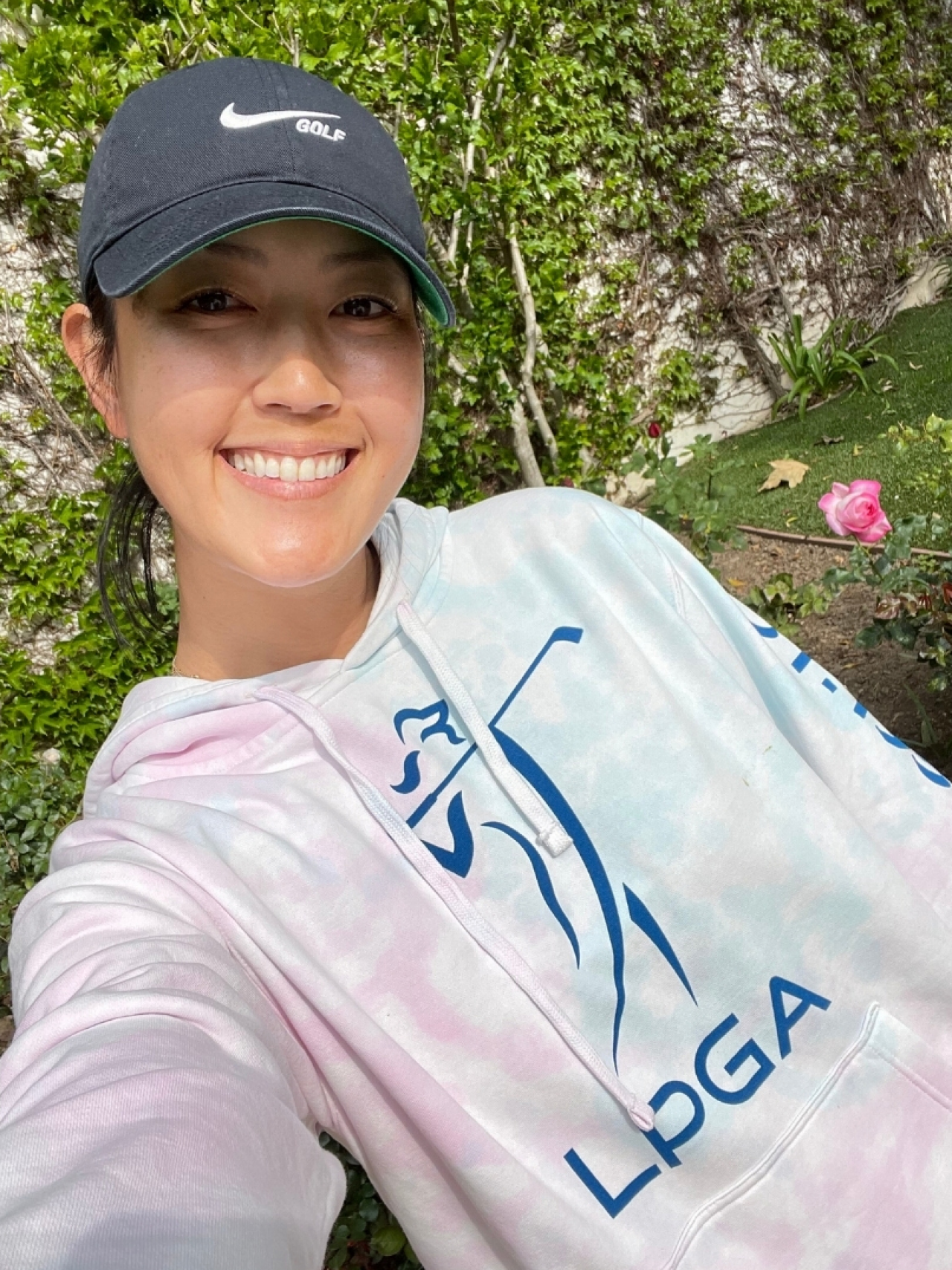
So what really needs to happen to drive change? After over two months of research and conversing with golfers from different backgrounds and varying perspectives, I came to the conclusion that occasionally I could be on board with moving tees closer, not for entertainment purposes or to bait viewers, but firstly to diversify the assortment of players at the top of the leaderboard, and secondly to give those folks (and their caddies) a better chance at winning tournaments. Additionally, why not add shot tracer to LPGA tournaments as my friend Tanner Gibas, media specialist for Denver City Golf Works suggests. The PGA and European tour have shot tracer every tournament, why don’t the ladies? Lastly, and maybe most importantly, we need continued support from mainstream sports media and men’s organizations to help promote LPGA tournaments and players. The hoodie for golf campaign is an amazing start, but I would like to see more athletes and influencers reposting shot highlights from LPGA tournaments and collaborating with players, just two examples of how LPGA can prove to new audiences that women are worth watching. All in all, it is time for women to be promoted as the main event and treated in the same manner as men, based on skill level and not gender.





